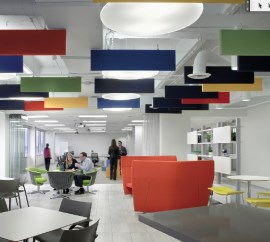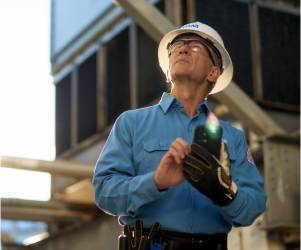In 1978, IFMA co-founders George Graves, IFMA Fellow, of Texas Eastern Transmission Corp.; Charles Hitch of Manufacturer’s Bank in Detroit and David Armstrong, IFMA Fellow, of Michigan State University voiced a need for an organization comprised of facility professionals from the private industry. In May 1980, Graves hosted a meeting in Houston, Texas, USA to establish a formal organizational base from which a facility management association could be built. Three decades later, IFMA is the world’s largest and most widely recognized association for facility management.
“Facility management is a great profession and you have a support system that will be with you. You go into it knowing you’ll have to expand beyond the building. It’s got a future to it. There are a certain number of people that will be interested and we will need to accommodate them. Thirty years ago it would have been wonderful to have the resources that IFMA has today. Thirty years ago it was just the beginning of the facility as a heartbeat.”—George Graves

IFMA operates from a centralized world service center facility in Houston, supporting an increasingly global membership base, representing 78 countries. Its challenges included legacy work processes and a physical environment that did not reflect the leading edge of the facility management profession.
Members expect and deserve timely and easy access to products, resources and staff across multiple channels anywhere, anyplace or time. Leadership pursued improved support for a diverse and global membership base through operational and commercial initiatives.
The outcome? The goal of IFMA’s new Service Center of Excellence is to deliver an effective and satisfying work environment, support a distributed service model and implement strategies for long-term flexibility and operational sustainability.
Why move? Why now?
The lease expiration of the association’s service center at 1 East Greenway Plaza in Houston was set to expire Dec. 31, 2012. From that, IFMA’s President and CEO Tony Keane and the board of directors agreed the association should embark on a journey to develop a new workplace and headquarters location. This lease expiration presented a unique opportunity to begin the strategic planning process with a clean slate and develop a workplace strategy that supports the way people work today, all while integrating the agility necessary to support how they will work in the future.
Some of the goals and commitments for the new workplace included:
- Providing an open and transparent relocation process;
- Not being limited by any existing space or location;
- Breaking the link between space and status;
- Being at least 25 percent more efficient than the previous workplace;
- Aligning with the IFMA strategy map to ensure long-term stakeholder value;
- Developing a strategy to guide decision making that aligns with the core themes of sustainability, operational excellence, global influence and community along each perspective of the balanced scorecard; and
- Providing a more effective and satisfying work experience.
What is a Service Center of Excellence?
A Service Center of Excellence is an organizational structure that provides thought leadership and proliferate delivery of information in specific areas of expertise and focus through training, best practices and organic knowledge sharing mechanisms.
IFMA’s Service Center of Excellence in Houston is the first of IFMA’s new approach to supporting members, customers and stakeholders. We envision establishing several strategic service centers of excellence around the globe to best carry forward the mission of IFMA.
The beginnings of a new work environment
The new work environment is the outcome of a best-in-class, robust process that included strategic partnerships with world renowned subject matter experts, sourced through a transparent and inclusive methodology that sets the benchmark for future engagements of its kind.
Discussions started with IFMA’s executive leadership and membership weighing in to provide an answer to a seemingly benign, but ultimately very complex question:
“What is the purpose of IFMA’s headquarters and how does it provide value to membership?”
The answer to that question resulted in a vision for IFMA’s future workplace and development of a human resource, technology and facility global kit of parts that can be flexibly deployed to support any business need—anywhere and at any time.
The first deployment of the IFMA global kit of parts is the Houston Service Center of Excellence, which was derived through the collaborative efforts of world-leading partners including AECOM/Strategy Plus (formerly DEGW), Jones Lang LaSalle Americas, Inc., Perkins+Will and Watchdog Real Estate Project Managers. Each of these partners were retained through a transparent, inclusive bid process that was led by the IFMA Headquarters Relocation Project Steering Committee and supported by dedicated IFMA members(refer to http://www.ifma.org/about/about-ifma/ifma-headquarters for the full listing and further details).
The process focused on three E’s—efficiency, effectiveness and expression:
- Efficiency-The new site is approximately 50 percent smaller in footprint than the previous location and is sustainably designed to support exponential business growth without increasing the footprint.
- Effectiveness-Strategically located, the new Service Center of Excellence enables continuity of operations and a seamless transition for membership and staff.
- Expression-The distributed workplace strategy (refer to the workplace strategy presentation in FMJ Extended section) developed in support of IFMA’s vision, enables Service Center of Excellence practitioners the flexibility to work in ways that best supports the business and their personal needs.
Reinforcing the vision
According to IFMA’s vision, the association strives to deliver an effective and satisfying work environment, support a distributed service model and implement strategies for long-term flexibility and operational sustainability.
In order to reinforce this vision, several design principles were followed:
- Universal access to a variety of spaces;
- Visual connectivity and project-based teams;
- Concentrative space;
- Informal collaboration space;
- Flexibility—more multi-use space;
- Current footprint reduction; and
- Space provision that is not status based.
“It was extremely important for IFMA’s senior leadership to define and provide a vision that identified IFMA’s desired future state and its implications.” said Thomas Mitchell, CFM, IFMA Headquarters Workplace Steering Committee chair. “The visioning process resulted in the IFMA executive committee’s decision to head in a direction where the desired end result was the establishment of a Service Center of Excellence. IFMA’s senior leadership demonstrated their investment to the project’s success by their decision to commit the time, talent, and finances necessary to turn the vision of a Service Center of Excellence into a physical reality.”
A wide variety of stakeholders were engaged with the goal of establishing the central design principles of the project. This began with conducting interviews with IFMA department heads to see how their groups currently worked and how a future workspace could better support them. In order to understand the larger organizational goals and aspirations that a future headquarters could support, steering committee members (who represent IFMA’s board of directors) also were interviewed.
Along with these interviews, focus groups were conducted with IFMA staff to better understand the current state of IFMA headquarters and how the new workplace could better support the association’s evolving methods of member service and collaboration. In addition, IFMA’s global membership was engaged with a survey which asked about how they typically interacted with IFMA headquarters and how these interactions could be improved.
A workplace survey also was conducted with IFMA staff—covering topics from IFMA workspaces to performance gaps in the workspace. The survey was complemented with a time utilization study. In this study, trained observers made regular observations of the IFMA workspace over the course of a workday. Through this process, it was determined how individual and collaborative workspaces and amenities were utilized. Through the combination of observational studies, employee feedback and the validation of data in employee focus groups, the creation of a program for a future workspace that could more closely align with IFMA’s vision of how it would work in the future evolved.

Transitioning into a collaborative, mobile office
Transforming the way a workforce group operates is not easy. The idea of an open, mobile and collaborative environment was presented by making good use of the results found on the workplace performance survey and time utilization study. Knowing that true acceptance to change only can come from within; the results of these studies show how employees viewed the past state of the organization, as well as themselves and what they see as a future. This presented a sound case for getting people open to the idea of this new way of working.
The new office showcases leading-edge mobility strategies for people and ideas both internally within the walls of the office and externally around the world. It features some of the best ideas and technologies drawn from the expertise of IFMA’s 23,000 facility management members and offers a unique example of what the workplace of tomorrow might look like (refer to the sidebar, Top Features of the New Workspace).
“There’s a reasonable expectation that a global association for facility management should run a state-of-the-art facility,” said Keane. “I’m proud to say that the Service Center of Excellence in Houston meets and exceeds this expectation. Over the last few years, we’ve completely reinvented the way our facility supports our ability to provide the quality services our members deserve. We’ve put theory into action and we’re pretty excited about the results.”
A facility that supports human mobility offers a wide range of advantages. Operational environments change from week to week, while the day-to-day needs of individual employees change as well. By rethinking its traditional fixed office layout and liberating employees from assigned workstations, IFMA is helping to drive change instead of merely reacting to it.
Sustainability in action
The new global headquarters employs a number of innovative technologies and techniques to benefit the triple bottom line of people, planet and profit.
Some of the ways the Service Center of Excellence was designed to be sustainable.
- Half the physical footprint-One of the most visible improvements with the Service Center of Excellence is a dramatically reduced physical footprint. Through employee mobility, shared workspaces and smart design, the new IFMA headquarters requires only about half the useable square footage compared with the previous space. The smaller, smarter space not only reduces the environmental impact, but also saves money and increases productivity.
- “Recycled” space-One strategy the IFMA Service Center of Excellence uses to do more with less is applying the concept of recycling to physical space. Just like recycled plastic can be used for something else, modular and convertible office spaces created throughout the facility can be quickly and easily repurposed for multiple uses, allowing one room to serve the function that required two or more in the previous location.
- Resource efficient-Furnishings, finishes and fixtures were chosen with sustainability as well as aesthetics and function in mind. To increase efficiency, occupancy sensors were installed facility-wide to turn off lights when rooms aren’t in use. IFMA will carefully monitor energy and water consumption in order to refine and improve conservation efforts.
- Environmental connection-To further connect people to each other and their environment, and to reduce the environmental and actual cost of lighting, the layout maximizes the penetration of daylight into the space while promoting line-of-sight views of the outside environment. This breaks down the indoor-outdoor barrier, and is further facilitated by using lower panels between workstations.
- Smart location-Even the location itself, in the heart of Houston’s Memorial City, was chosen with sustainability in mind. The development density and community connectivity means that a host of amenities are within walking distance. The building itself is a high-performance, facility with an ENERGY STAR® rating of 98.
- Commuter friendly-By utilizing mobile technology, IFMA not only empowers mobility within the workplace, but outside of it. When it is not necessary to physically be in the office, employees can work remotely, allowing them to reclaim time lost in a daily commute while reducing fuel consumption and vehicle emissions thus lowering the carbon footprint.

A true world headquarters
The Houston Service Center of Excellence wasn’t designed to be unique. In fact, it was designed to be easily copied. Additional service centers of excellence will be opened around the world, duplicating the original format where appropriate and bringing unique functionality when necessary. By disbursing specific organizational responsibilities around the world, and empowering them all to work together seamlessly, IFMA creates international collaboration and eliminates the need for useless duplication.
“The idea that a facility can actually shape the way people think and act is one of the core concepts of facility management,” said IFMA Chair and Chief Elected Officer Marc S. Liciardello, CFM, MBA, CM. “There’s a reason the first word in our association’s name is ‘International.’ The global scope of what we do is part of who we are, and that was evident in the earliest brainstorming sessions about what we wanted in IFMA’s new Service Center of Excellence. To promote and support global thinking, we sought out leading-edge design theories and best practices from our 23,000 members and integrated them into the office. With careful strategic planning, our new facility is a powerful tool that shapes the way we work and think.”
For more details, complementary videos, photo library and the workplace strategy presentation, go to http://www.ifma.org/about/about-ifma/ifma-headquarters. FMJ
Top features of the new workspace
A collaborative community was the desired image for IFMA’s new office. It embraces new workplace strategies that directed the design of the new work environment.
Signage
The entry leaves no question that “you have arrived” at the IFMA Service Center of Excellence. Veneer wood panel acts as a backdrop to offsets an 8′-0″ layered translucent IFMA graphic. The entry and reception are part of the primary circulation path and are activated by staff and visitors throughout the day. Video displays built into the wall offer a glimpse into IFMA’s history, current events and highlight past/present leadership of the organization.
Color
An international approach to color—red, blue, green and yellow—provides accents throughout the space and is supported by a neutral base palette. To ensure a timeless space, the flooring, millwork and primary wall colors are medium tones in warm neutral colors.
Lighting
Considerations for lighting were important in all areas to ensure work could happen anywhere in the space. Direct/indirect light fixtures were utilized to provide even light levels and reduced glare for users. Accent fixtures were included to highlight specialty areas like the reception area, break room, lounge and gathering areas. View to the outside can be experienced from almost anywhere in the office. Exterior windows bring daylight deep into the space. The lounge area takes full advantage of the natural light and panoramic view of the surrounding landscape.
Worksettings
Open work areas include groups of touchdown stations that allow for focused work or group collaboration. Work areas include low screens between users, but allow for easy collaboration between staff that can congregate within a pod as needed to work collectively or to focus on heads-down work while staying in tune with others.
Focus and meeting rooms
Open environments demand some space be dedicated to closed spaces that accommodate various tasks, both for the individual and groups. Focus rooms spread throughout the space allow for small meeting or singular work in a closed area. Meeting rooms allow for group meeting of six to eight people. All rooms include glass panels to ensure transparency throughout the space and keep staff connected no matter what they are work on or who they are working with. Meeting rooms feature audio/video connections and visual write wall surfaces.
Technology
The entire space is Wi-Fi-enabled with incredibly fast speed. But if traditional connections are preferred, those are available at all open area worksettings, focus rooms and meeting rooms. Every staff member was also provisioned with laptops, VPN (virtual private network) and unified communications software, including telephone and audio capabilities.
Mobility
Trust among staff members and technology enhancement are two key ingredients for making a mobile work environment successful. Once those functions are established, the workplace itself needs to conform to the new paradigms that emerge. Focus shifts from the need for private personal space to an offering of various collaborative, in person, spaces. This doesn’t mean that those spaces for focused heads-down work don’t exist, but they can be smaller and co-located. This co-habitation of space also facilitates staff interaction and cross-communication between different departments and quickly can forge new bonds and understanding between staff.
The lounge
A bright open loft-like lounge area is open to everyone and adjacent to the multipurpose room and allows staff to opt for a relaxed den or café experience inside the office. The exposed structure overhead and colorful acoustical baffles along with the eclectic mix of lounge/café furniture makes this space friendly and available any time of day. Relax at lunch, catch the latest news story, connect to Wi-Fi and get some work done or gather a group for a cup of coffee— this space can handle it all.
Naming conventions
The space includes a thoughtful approach to the international nature of the organization through the graphic signage package. Work areas bare the names of continents, while closed focus rooms and meeting rooms bear country names from locales around the world where there is an IFMA presence.




